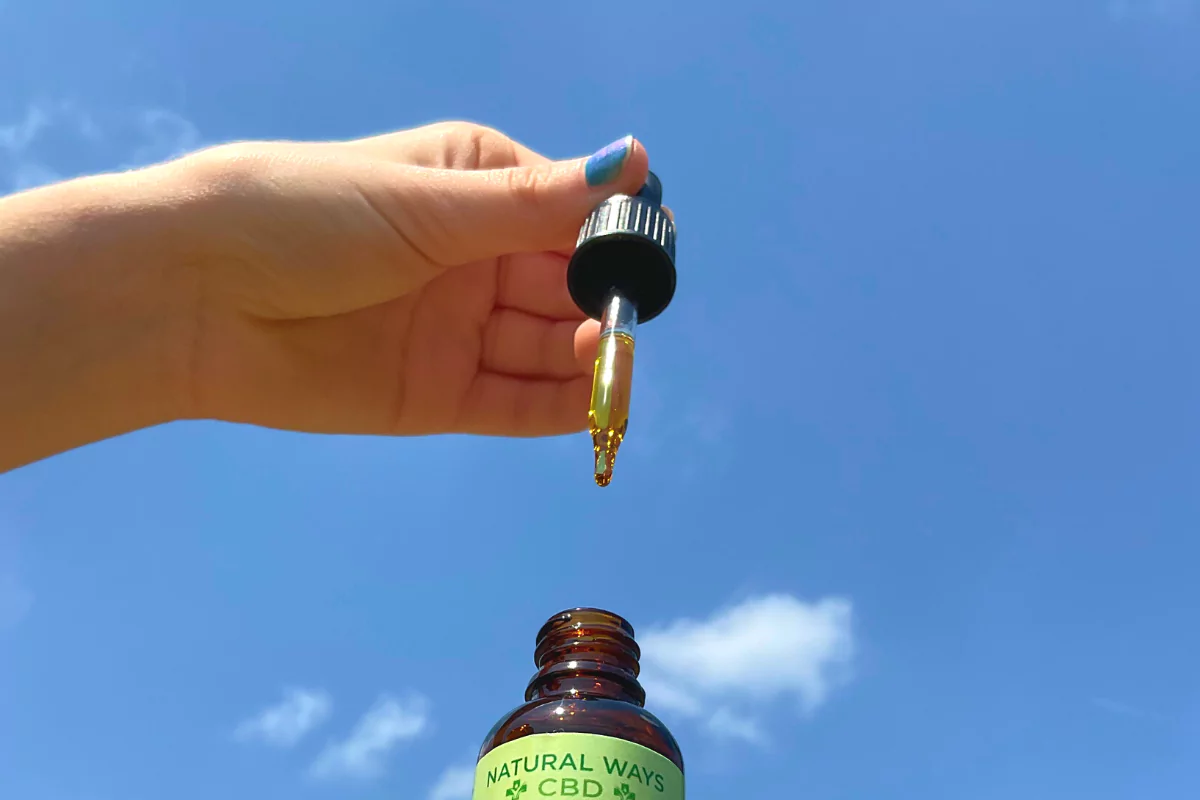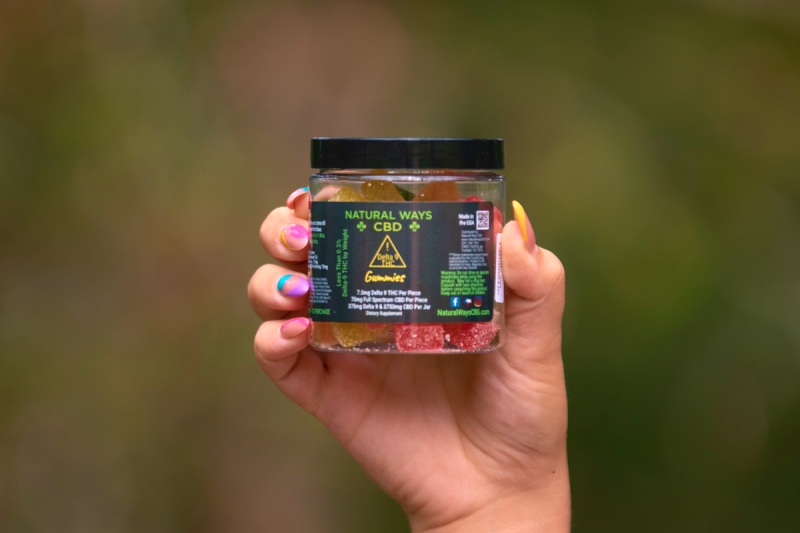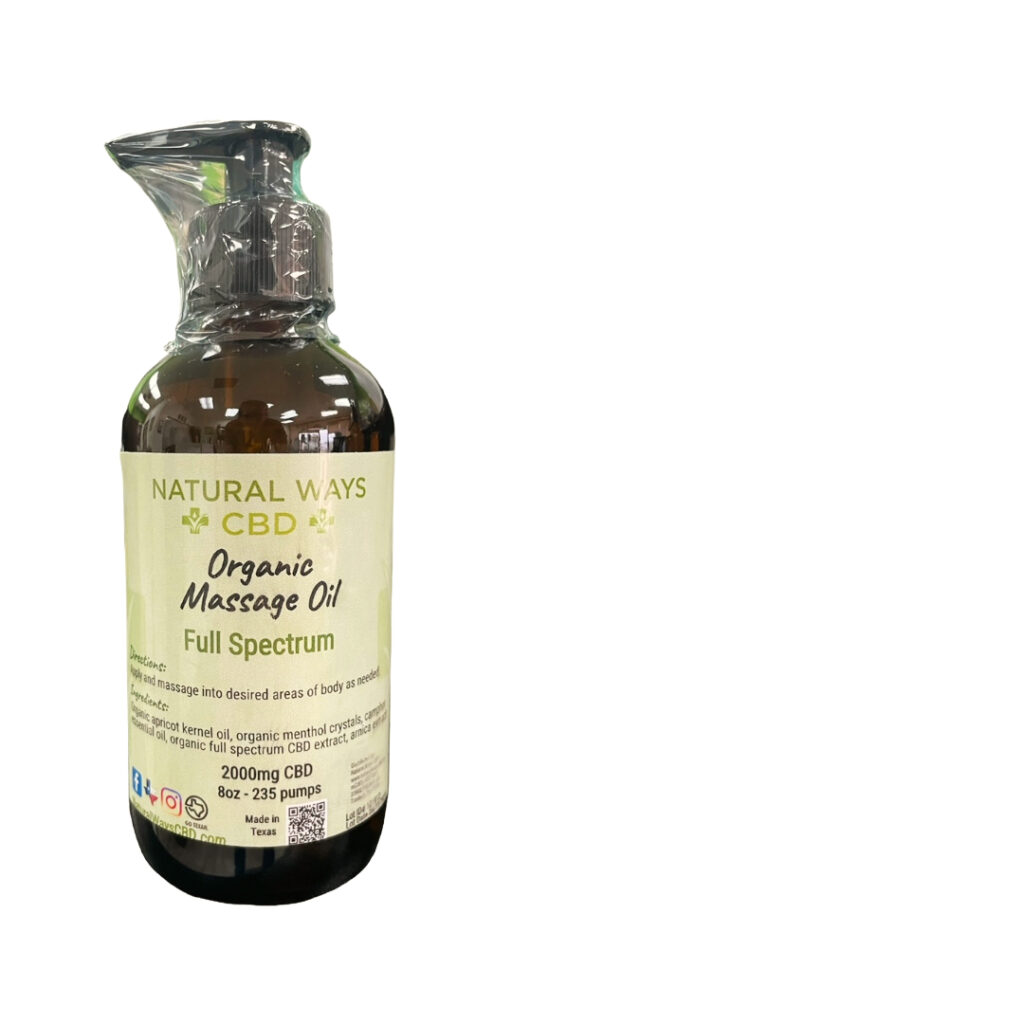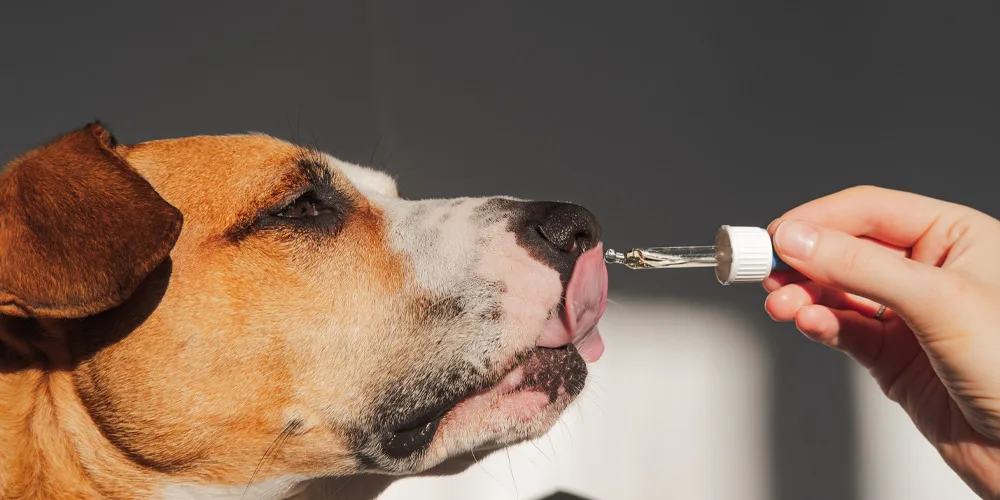Will CBD actually help with migraines?
While cannabinoids affect everyone differently, research suggests CBD has therapeutic potential for migraines and other headaches, especially when used in combination with tetrahydrocannabinol (THC).
In this article, we’ll look at that research on CBD for migraines and discuss how to use it. We’ll also explore how, in many cases, a combination of CBD and THC is better than CBD alone.

What is CBD?
Cannabidiol (CBD) is a naturally-occurring cannabinoid in the cannabis sativa plant (hemp is cannabis sativa that contains less than 0.3% THC by dry weight).
There are more than 100 cannabinoids in hemp, but CBD is one of the most commonly-used because of its high abundance and potential therapeutic uses. It’s been researched for pain, inflammation, anxiety, insomnia, epilepsy, and many other uses.
Unlike THC, CBD is not inebriating. It is technically psychoactive, in that it affects the mind, but it tends to create mild feelings of calm and relaxation, rather than the sensations you’d normally associate with a high.
Can CBD Help With Migraines?
Research suggests CBD has therapeutic potential for people with migraines. However, many studies find that using CBD in combination with THC renders a greater benefit than using CBD by itself.
Studies also show that CBD is capable of reaching areas of the brain involved in migraine pain.
More scientific research is needed, though, before we can be confident in the ability of CBD, THC, or both to treat migraines.
For right now, these two cannabinoids are best regarded as natural supplements, rather than robust replacements for traditional migraine treatment methods.
The Research on CBD for Migraines
Several studies have looked at the therapeutic potential of CBD, THC, and cannabis, in general, at addressing migraines and the issues surrounding them.
Research on medical cannabis for migraines
Several studies have looked at the use of medical cannabis, which tends to contain large percentages of THC and CBD, for migraines.
A 2024 clinical trial involving 92 participants and 247 migraine attacks sought to determine the efficacy of vaporized cannabis flower at addressing migraines.
The researchers tested three types of strains: those containing a balance of CBD and THC, those containing a preponderance of CBD, and those containing a preponderance of THC.
Across two different measures, the CBD:THC flower was more effective at promoting comfort than either the THC-dominant or CBD-dominant blend. And while the CBD-dominant blend showed no benefits, the CBD:THC blend outperformed the THC-dominant blend [1].
Another study analyzed data from 1373 headache center patients, 55.7% of whom reported using cannabis-based products in the past 3 years. The most commonly-used cannabinoid blend among the patients was THC:CBD.
A majority of the patients reported cannabis-associated improvements in their migraine headaches (intensity: 78.1%, duration: 73.4%, frequency: 62.4%).
Nearly half (48.9%) of the respondents reported that cannabis use contributed to a reduction in medication amount for headache treatment, and 14.5% reported an elimination of other medications [2].
Lastly, a 2021 review of literature found that medical cannabis use tends to decrease migraine duration and frequency [3].
Research on CBD for migraines
While research on medical cannabis (which contains both THC and CBD) is promising, studies looking at CBD are mixed.
A 2023 research paper found that there is limited research to prove that CBD is an effective treatment for migraine [4].
However, other research suggests CBD has benefits. A 2023 study found that CBD reaches brain areas involved in migraine pain and is able to modulate migraine-related pain signaling [5].
From these studies, it’s safe to say that CBD may be beneficial for migraines, but is far more effective when used alongside THC.
However, more studies are needed before we know how reliable cannabinoids, in general, are for migraines. They aren’t yet a recognized treatment. Instead, they should be regarded as supplements.

How CBD Works
CBD works by supporting your endocannabinoid system (ECS). The ECS is a receptor system in your body that’s responsible for regulating your vital functions, including your inflammatory and pain responses.
The two main types of receptors in your ECS that cannabinoids interact with are the CB1 and CB2 receptors.
CB1 receptors produce mental effects when activated, while CB2 receptors produce physical effects upon activation.
Cannabinoids like THC tend to work mostly with the CB1 receptors, while CBG (cannabigerol) and CBN (cannabinol) may activate both CB1 and CB2 receptors.
CBD, however, doesn’t interact heavily with either type of receptor. Instead, research suggests that it may work by preventing the breakdown of your endocannabinoids (internal cannabinoids) [6].
A specific example is the endocannabinoid anandamide. Research suggests CBD may inhibit the breaking down of anandamide, which activates endocannabinoid receptors to relieve pain [7,8].
Low levels of anandamide are associated with migraine pain; studies suggest anandamide is a promising therapeutic target for the treatment of migraines [9].
CBD may regulate how anandamide is transmitted within the body, thereby promoting physical balance.
How to Use CBD For Migraines: Products & Dosage
There are several ways you can use CBD for migraines, and each is beneficial in different circumstances. Instead, we recommend choosing between them based on your situation.
- Oil – CBD oil consists of hemp extract and carrier oil. Because it can be put under the tongue, then swallowed, it starts working in just 10-15 minutes and is slightly more potent than other delivery methods.
- Gummies – CBD gummies are a good option if you’ll be taking the same dose of CBD on a regular basis. Gummies take 45 minutes to 1 hour to kick in.
- Softgels/Capsules – CBD softgels and capsules offer a cleaner, quicker alternative to gummies. They are a perfect option if you want to easily integrate CBD into your vitamin routine. However, capsules can’t be split like gummies can.
- Topicals – CBD topicals are applied to the skin, rather than consumed orally. Topicals don’t deliver CBD to the bloodstream, so they won’t give you full-body benefits. However, they can target specific affected areas.
- Flower/Vapes – CBD hemp flower and CBD vapes are two other ways you can consume CBD for migraines. However, they pose two downsides: first, the obvious health risk of inhaling smoke or vapor, and second, the difficulty of getting a precise dose. Still, these downsides may be worth it for you, depending on your needs and preferences.
CBD Dosage for Migraines
Start out, we recommend taking a medium-strength CBD dosage for migraines:
(0.3) x (your body weight in lbs.) = your daily CBD dosage in mg. for migraines
As you go, gradually increase your daily CBD dosage depending on how it’s working for you.
You’ll need to take CBD consistently for at least 2 weeks in order to begin seeing benefits, because it will need to build up in your body to have the full effects.
Unlike THC, CBD does not typically have a considerable effect on the first dose.
Why THC and CBD Are Better for Migraines than CBD Alone
Most of the research on medical cannabis for migraines finds that THC:CBD combinations work better for migraines than either THC or CBD by themselves.
This is likely due to a theory known as the entourage effect, which says that taking different compounds in the hemp plant together can deliver unique and elevated benefits when compared to taking cannabinoids in isolation.
Taking THC and CBD together is generally the best way to use these cannabinoids. Anecdotal evidence suggests that this combination leads to:
- Greater benefits
- Fewer side effects, in particular, a reduction in THC’s inebriating effects
- Improved circulation and absorption of both cannabinoids
This combination exists in full-spectrum CBD – the naturally-occuring form of CBD – which contains small amounts of THC and other cannabinoids.
In terms of THC:CBD ratios for migraines, there is no scientific research on what’s best.
Anecdotally, some people prefer a CBD-dominant blend, while others like a THC-dominant blend. Whatever the ratio you use, using CBD and THC together will always be better than using CBD or THC by itself.

CBD for Migraines: Side Effects & Risks
Research suggests CBD is safe and well-tolerated, even if you take large doses and use it regularly.
However, CBD has the potential to cause the following side effects:
- Dry mouth
- Drowsiness
- Diarrhea
- Reduced appetite
- Fatigue
Most people don’t feel the side effects, however, they are important to be aware of.
Is CBD Legal?
Yes, CBD is federally legal in the United States.
The 2018 Farm Bill (which has been extended through 2024) legalized hemp and hemp-derived cannabinoids, including CBD, on a federal level.
Hemp is a variant of the cannabis sativa plant that contains less than 0.3% THC by dry weight.
When to Talk to Your Doctor
Although CBD is very beneficial, we always recommend talking to your doctor first if you’re experiencing chronic migraines. They will be able to advise you on which treatment is best.
While CBD is research-backed, it’s not yet a proven treatment and should not be used in place of one.
Conclusion: Is CBD an Effective Natural Migraine Supplement?
Research suggests CBD has therapeutic potential for migraines, particularly when combined with THC.
That’s because cannabinoids work best when taken in their natural form: alongside each other.
However, if you can’t use THC due to drug testing concerns or other reasons, you may still see benefits with broad-spectrum CBD or CBD isolate.
CBD for Migraines: Frequently Asked Questions
Here are some questions our customers frequently ask us about CBD for migraines.
Does CBD do anything for migraines?
By itself, CBD may render therapeutic benefits for migraines. However, it is more effective when taken alongside THC.
How much CBD does it take to get rid of a migraine?
There is no set CBD dose for migraines, however, we recommend starting with a medium-strength dosage and working your way up. You can calculate your dose using this formula: (0.3) x (your body weight in lbs.) = your daily CBD dosage in mg.
Does CBD help with nausea and headaches?
There is research on CBD for nausea that suggests it may be beneficial, however, CBD is not a proven treatment for nausea or headaches.
Can too much CBD cause migraines?
No, there is no research to suggest CBD will cause migraines, although taking an overly large dose may cause a milder headache.
Sources
[1] Schuster, Nathaniel M et al. “Vaporized Cannabis versus Placebo for Acute Migraine: A Randomized Controlled Trial.” medRxiv : the preprint server for health sciences 2024.02.16.24302843. 18 Feb. 2024, doi:10.1101/2024.02.16.24302843. Preprint.
[2] Starkey, Brianna et al. “Characterizing Cannabis Use and Perceived Benefit in a Tertiary Headache Center Patient Sample.” Neurology. Clinical practice vol. 14,2 (2024): e200285. doi:10.1212/CPJ.0000000000200285
[3] Poudel, Sujan et al. “Medical Cannabis, Headaches, and Migraines: A Review of the Current Literature.” Cureus vol. 13,8 e17407. 24 Aug. 2021, doi:10.7759/cureus.17407
[4] Sturaro, Chiara et al. “Preclinical effects of cannabidiol in an experimental model of migraine.” Pain vol. 164,11 (2023): 2540-2552. doi:10.1097/j.pain.0000000000002960
[5] Greco, Rosaria et al. “Characterization of the biochemical and behavioral effects of cannabidiol: implications for migraine.” The journal of headache and pain vol. 24,1 48. 3 May. 2023, doi:10.1186/s10194-023-01589-y
[6] Chye, Yann et al. “The Endocannabinoid System and Cannabidiol’s Promise for the Treatment of Substance Use Disorder.” Frontiers in psychiatry vol. 10 63. 19 Feb. 2019, doi:10.3389/fpsyt.2019.00063
[7] Hua, Daniel Ying-Heng et al. “Effects of cannabidiol on anandamide levels in individuals with cannabis use disorder: findings from a randomised clinical trial for the treatment of cannabis use disorder.” Translational psychiatry vol. 13,1 131. 21 Apr. 2023, doi:10.1038/s41398-023-02410-9
[8] Clapper, Jason R et al. “Anandamide suppresses pain initiation through a peripheral endocannabinoid mechanism.” Nature neuroscience vol. 13,10 (2010): 1265-70. doi:10.1038/nn.2632
[9] Greco, Rosaria et al. “Endocannabinoid System and Migraine Pain: An Update.” Frontiers in neuroscience vol. 12 172. 19 Mar. 2018, doi:10.3389/fnins.2018.00172






